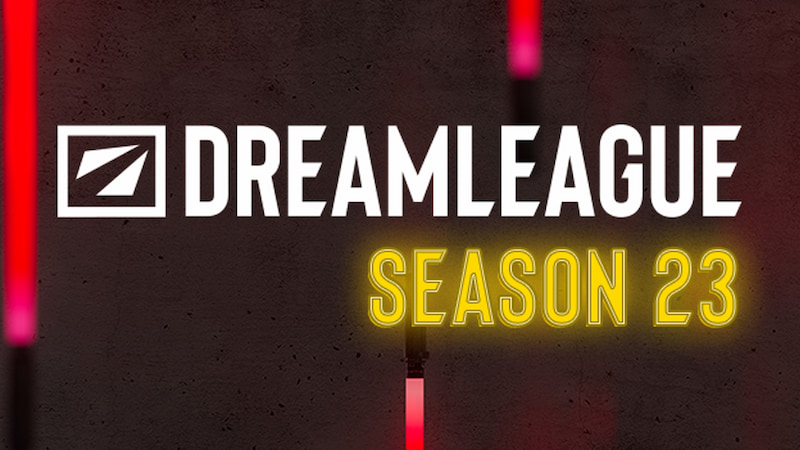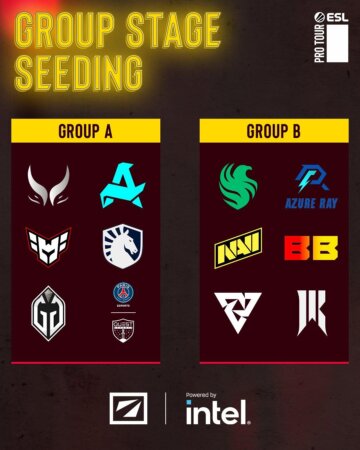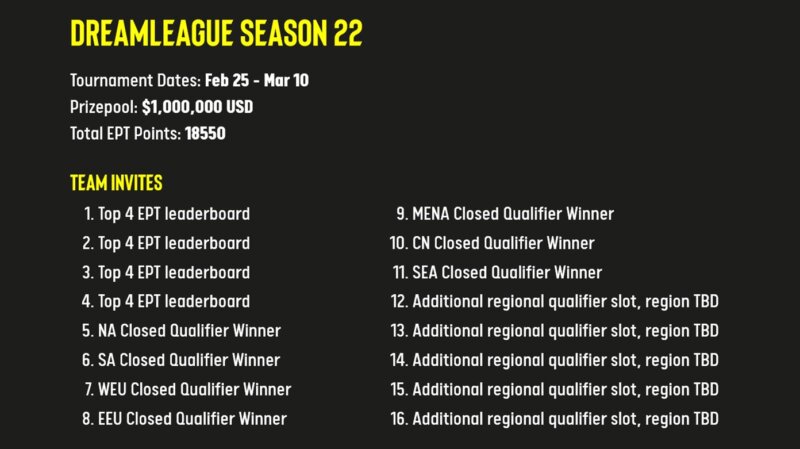DreamLeague Season 23 Dota 2 – Event Info, Schedule & Teams
DreamLeague is back once again with its twenty-third season, and nobody’s complaining. With the Dota 2 competitive scene being at its peak performance, all the fans want is more action regardless of the tournament.
So, mark your calendars for DreamLeague Season 23, going live from May 20 to 26.

Image Credits: DreamLeague
Watch Dota 2 DreamLeague Live:
The tournament first matches begin on May 20, featuring the best-in-class teams from the ESL Pro Tour Leaderboard and several qualified teams. Catch the matches happening on ESL Dota 2 Twitch channel:
DreamLeague Season 23 Format
Unlike its predecessor, which featured an uncommon tournament format, ESL has returned to its classic group stage format. Twelve teams are divided into two single round-robin groups, where each series is best-of-two. Top two teams advance to the Upper Bracket of Playoffs while third and fourth-place teams still advance to the Lower Bracket of Playoffs. Unfortunately, the bottom two seeds from each group will face early elimination.
Then, the Playoffs will only have the top eight teams remaining, where a double-elimination bracket is in place. Playoffs matches are best-of-three, and at last, the grand finals are best-of-five.
The DreamLeague S23 is the final tournament before the EPT Leaderboard finalizes, so it’s every team’s last chance to earn EPT points. This, of course, will determine the top eight teams on the leaderboard to get an invite to the Riyadh Masters this year.
DreamLeague Season 23 Invited Teams
DreamLeague Season 23 boasts a fantastic line-up of promising teams. From the EPT Leaderboard, the invited teams are BetBoom Team, Xtreme Gaming, Gaimin Gladiators and Team Falcons. Unfortunately, Team Spirit did not quite make the cut here despite winning the recent PGL Wallachia S1.
The regional qualifier winners ups the antic with underdog energy, featuring Team Liquid, Tundra Esports, Natus Vincere, PSG Quest, Azure Ray, Aurora, Shopify Rebellion and HEROIC. This mix of teams from various regions, each bring their unique playstyles and strategies, sets the stage for a thrilling match-up.

Image Credits: ESL
Favorites at DreamLeague Season 23
Hailing from their recent success at PGL Wallachia S1 are Xtreme Gaming and Team Falcons, which are second only to Team Spirit. Since the latter is absent at DreamLeague S23, this should make for unrivalled competition for these heavy hitters.
Another team that has remained out of the radar is Tundra Esports, which packs quite a prominent roster on paper. From the two-time champion, Topias “Topson” Taavitsainen, to the Russian prodigies Roman “RAMZES666” Kushnarev and Ivan “Pure” Moskalenko, Tundra has what it takes to be a force to be reckon of.
Returning powerhouses at DreamLeague Season 23
Aside from the top dogs that will likely rule the DreamLeague S23, there are several tournament staples, which may put up a fight. One notable team is Shopify Rebellion, bringing the new debut of Andrei “skem” Ong into their active roster. Fans are looking forward to see the new SR in action with their new player.
Azure Ray and Aurora aren’t too shabby themselves, but have yet to prove their strength despite the high anticipation for teams of such calibre. Then, there’s Natus Vincere, which nobody expected to make a comeback in 2024 as a decent Eastern European contestant that defeated Team Spirit and Virtus.pro in the qualifier for this spot.
Regardless of the high hopes and underdog energy these teams give off, their chances of qualifying for Riyadh Masters 2024 by EPT Leaderboard are essentially non-existent given the point gap. Nevertheless, making a quick buck off the DreamLeague S23’s generous million-dollar prize pool is still worthwhile.
Mark your calendars for DreamLeague Season 22, happening from February 25 to March 10. This season’s DreamLeague event is pivotal as it paves the way for teams to secure future spots, potentially for the annual International Championship and of course, the ESL Pro Tour (EPT) series of tournaments. A mix of experienced teams from previous tournaments and some new challengers makes this edition of DreamLeague particularly intriguing, and it’s also the first 2024 debut for many teams. The tournament’s schedule will be packed with matches starting on February 25, showcasing the best talent across every region, each fighting for dominance in DreamLeague S22. For now, you can catch the regional qualifier matches happening on ESL Dota 2 Twitch channel: DreamLeague Season 22 adopts an unorthodox tournament format this time around, comprising two levels of group stages followed by the playoffs. In the First Group Stage, teams are split into two groups of eight, competing in a best-of-two single round-robin format. The top four teams from each group move on to the Second Group Stage, which also follows a single round-robin format but consists of only one group of the top eight teams from the first stage. This leads to the Playoffs of only the top four teams remaining, where a double-elimination bracket ups the stakes. Playoffs matches are best-of-three, culminating into the best-of-five grand final. Teams are not just competing for the title but also aiming to secure crucial EPT points and a slice of the $1 million prize pool. This, of course, could lead to an invitation to the grandest stage in the International Championship and the Riyadh Masters. DreamLeague Season 22 boasts a diverse lineup of teams. From the EPT Leaderboard, the top four teams like Team Liquid, BetBoom Team, Gaimin Gladiators, and Xtreme Gaming have earned their spots. The regional qualifiers have added another layer of competition with Team Spirit, Virtus.pro, Klim Sani4, Azure Ray, G2.iG, and Shopify Rebellion already securing their places at DreamLeague S22. This mix of teams from various regions, each bringing their unique playstyles and strategies, sets the stage for a thrilling match-up. DreamLeague S22 Team Slot Allocation (Image credit: ESL Gaming) The factors of team performance and roster changes since ESL One Kuala Lumpur 2023 have significantly impacted the outlook for DreamLeague Season 22. Teams with a history of success at major tournaments, including past champions, are expected to perform well. Notably, the spotlight is on Team Spirit, the TI12 winners. Then there are the top finishers at ESL One Kuala Lumpur 2023, namely Xtreme Gaming (formerly Azure Ray) and Gaimin Gladiators, have proven to be a formidable force, making them some of the top contenders. Another team to watch out for is Team Liquid, who have shown they can go toe-to-toe with the best, thanks to their consistent roster. DreamLeague Season 22 is also swarmed with well-known teams that haven’t participate since TI12, such as Team Spirit, Shopify Rebellion, and Virtus.pro to redeem their dominance. Then, there are teams like Klim Sani4 and G2.iG, which have potential to rival these top teams at DreamLeague S22. Regardless, one thing’s for certain is that most of the heavy hitters are back from the holiday hiatus, so it’s not going to be a walk in the park for the participants at DreamLeague S22.
Watch Dota 2 DreamLeague Live:
DreamLeague Season 22 Format
DreamLeague Season 22 Invited Teams

Favorites at DreamLeague Season 22
Returning powerhouses at DreamLeague Season 22
DreamLeague in 2023 was second only to Dota 2 Majors and The International. The ESL Pro Tour features three tournaments this season. Thus far, Gaimin Gladiators snatched both DreamLeague S19 and S20 victories, claiming $600K in winnings and a direct invite to Riyadh Masters 2023.
We are now heading into DreamLeague Season 21 between September 18-24, serving as the last stop before The International.
DreamLeague & ESL Pro Tour 2023 – Events Info & Teams
DreamLeague usually lasts only 2 weeks, featuring two Group Stages and one Playoffs Bracket. While it may seem rushed and stressful to have so many games packed into only two weeks, this is rather ideal.
DreamLeague S21 features a generous $1M prize pool similar to its predecessor, but that’s merely a fraction of the tour’s $17M prize pool. The stakes were higher for DreamLeague Season 20 and 19 woth both featuring Riyadh Masters spots as a reward. Season 21 will instead serve as a mini bootcamp, as ESL decided to break the mold by announcing this $1M Dota 2 tournament just a month before The International 12 (TI12).
DreamLeague Season 21 will feature 12 of the top teams in the Dota 2 landscape. Ten of these teams have already been confirmed, including big names like Team Liquid, Tundra Esports, and Evil Geniuses.
Why Now?
The timing of this tournament is particularly intriguing, especially considering the recent conclusion of the Riyadh Masters in July. DreamLeague had served as a qualification tournament for the Riyadh Masters, and many had assumed that we wouldn’t see another DreamLeague event until 2024. Yet, here we are, and it’s a game-changer.
How are DreamLeague Teams invited?
Dota 2 fans have often expressed outrage over tournaments that invite undeserving teams. For instance, when ESL One invited Alliance and Nigma Galaxy to ESL One Malaysia 2022 despite underperforming throughout the season.
As such, ESL One revamped their ESL World Rankings system for Dota into the transparent and improved EPT Ranking System. Hence, you might have noticed how many formidable teams are participating in DreamLeague S20.
DreamLeague S21 invites sixteen world-class teams, which includes the two-time consecutive Major champion, Gaimin Gladiators. Alongside are hordes of formidable rivals, such as:

Image source: ESL One
- Gaimin Gladiators
- Team Spirit
- Talon Esports
- Evil Geniuses
- Shopify Rebellion
- 9Pandas
- Team Liquid
- BetBoom
- Tundra Esports
- Quest Esports
EPT Ranking System for Dota 2
In short, the EPT Ranking System is an Elo-based ranking system for both teams and regions. We won’t get into the specifics, but it essentially ensures that there’s a baseline of one secured slot per region. Whereas stronger regions, or higher Elo, can earn additional slots.
As such, the EPL Pro Tour doesn’t just become another exclusive tournament for the powerhouses to rake in more winnings on top of their DPC 2023 participation. Instead, we have budding stars, such as noun and Execration, who have another revenue source to sustain their operations.
Bigger, Better, More DreamLeague than Ever
After such a successful delivery at the DreamLeague S19 and Season 20, fans are looking forward to the next iteration. With the same amount of anticipation and prize pool at stake, DreamLeague S21 is certainly a must-watch.
The DreamLeague S21 unfolds just after the Regional Qualifiers for Ti12 conclude. It’s a relatively similar bunch of participants as the last season’s, but this time, there’s more to look forward to than just Gaimin Gladiators. After all, Gaimin won two majors and DreamLeague S19 and 20.
We can potentially expect new challengers in town in Quest Esports. And of course, we can’t exclude 9Pandas, the Eastern European squad garnering attention after placing third at Berlin Major. Thus, it’s certainly no better time to be an excited Dota 2 fan because DreamLeague S21 is around the corner.

















